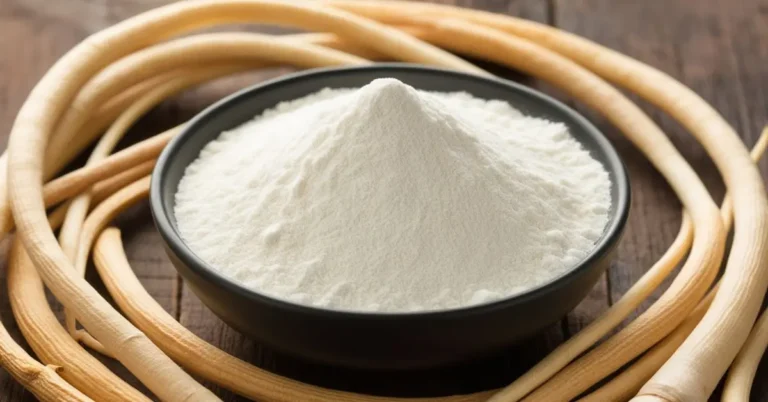Arrowroot powder is a versatile ingredient with a rich history and a wide range of applications in both culinary and medicinal fields. This article delves into the origins, properties, uses, and benefits of arrowroot powder, providing a comprehensive understanding of this remarkable substance.
Introduction
Arrowroot powder, a fine, white, odorless, and flavorless starch, is derived from the rhizomes (underground stems) of several tropical plants, primarily Maranta arundinacea. Known for its thickening properties, it has been used in cooking, baking, and as a medicinal remedy for centuries. Its neutral flavor and texture make it an ideal choice for various recipes, while its health benefits have made it a popular alternative to other starches and thickeners.
Historical Background
Ancient Origins
The use of arrowroot powder dates back to indigenous cultures in the Caribbean and South America, where it was initially used as a food source and a medicinal remedy. The name “arrowroot” is derived from the Arawak word “arurú,” which refers to the plant’s use in treating wounds from poisoned arrows. Indigenous people discovered that the powder made from the plant’s rhizomes had remarkable properties that could soothe and heal wounds, leading to its name and widespread use.
European Introduction
Arrowroot was introduced to Europe in the 17th century by explorers and traders. It quickly gained popularity due to its superior thickening abilities compared to other starches available at the time. By the 18th century, it had become a staple ingredient in European kitchens, valued for its versatility and neutral flavor.
Production and Processing
Cultivation
Arrowroot is typically grown in tropical and subtropical regions. The plant thrives in well-drained soil with plenty of moisture. It is often cultivated in countries such as Brazil, India, the Philippines, and parts of Africa. The rhizomes are harvested after about 9 to 12 months of growth, once the plant has matured and the leaves begin to die back.
Extraction
The process of extracting arrowroot powder involves several steps:
- Harvesting: Mature rhizomes are carefully dug up from the soil.
- Cleaning: The rhizomes are washed thoroughly to remove dirt and debris.
- Peeling: The outer skin of the rhizomes is peeled off to reveal the white, starchy core.
- Grinding: The peeled rhizomes are grated or ground into a coarse paste.
- Washing: The paste is washed with water to separate the starch from the fibrous material.
- Drying: The starch is dried to a fine powder, which is then sifted to ensure a smooth texture.
Nutritional Profile
Arrowroot powder is low in calories and fat, making it a favorable choice for those looking to maintain a healthy diet. Its primary component is starch, which provides a source of carbohydrates. However, it is relatively low in essential nutrients like vitamins and minerals. The nutritional profile of arrowroot powder can be summarized as follows:
- Calories: Approximately 20 calories per tablespoon
- Carbohydrates: 5 grams per tablespoon
- Protein: 0 grams
- Fat: 0 grams
- Fiber: 0 grams
Despite its lack of vitamins and minerals, arrowroot powder is a useful addition to a balanced diet due to its digestive benefits and its role as a thickening agent.
Culinary Uses
Thickening Agent
One of the primary uses of arrowroot powder is as a thickening agent in cooking and baking. It is often used in sauces, soups, gravies, and puddings. Unlike some other starches, arrowroot does not become cloudy or lose its thickening power when reheated. It also maintains its thickening ability at lower temperatures, making it an excellent choice for delicate dishes.
Baking
In baking, arrowroot powder can be used as a substitute for flour or cornstarch. It is particularly useful in gluten-free recipes, as it helps to create a light and airy texture in baked goods. Arrowroot powder can be used in combination with other gluten-free flours to improve the texture and consistency of cakes, cookies, and bread.
Recipes
Arrowroot Pudding: A classic use of arrowroot powder is in making a smooth and creamy pudding. Simply mix the powder with milk and sugar, then cook over low heat until thickened. Flavorings such as vanilla or chocolate can be added for variety.
Thickened Sauces: Arrowroot powder is ideal for thickening sauces and gravies. Mix it with a small amount of cold water to create a slurry, then stir it into the hot liquid. The sauce will thicken quickly without becoming lumpy.
Gluten-Free Baking: For a light and airy texture in gluten-free baked goods, combine arrowroot powder with other gluten-free flours. It helps to improve the consistency and rise of cakes and cookies.
Medicinal and Health Benefits
Digestive Health
Arrowroot powder is known for its gentle effect on the digestive system. It is often used as a soothing remedy for gastrointestinal issues such as diarrhea, nausea, and indigestion. Its easily digestible starch makes it a suitable food for those recovering from illness or undergoing digestive distress.
Nutritional Supplement
In some cultures, arrowroot powder is used as a nutritional supplement for infants and the elderly. It is often included in baby foods and dietary supplements due to its easy digestibility and minimal risk of causing allergic reactions.
Wound Healing
Historically, arrowroot powder has been used to treat wounds and skin irritations. Its soothing properties make it a popular choice for creating poultices and ointments that can help alleviate discomfort and promote healing.
Comparison with Other Starches
Cornstarch
While both arrowroot powder and cornstarch are used as thickening agents, there are some key differences. Arrowroot powder has a finer texture and is less likely to form lumps compared to cornstarch. It also maintains its thickening power when reheated, whereas cornstarch can break down and lose its effectiveness if the dish is reheated multiple times.
Tapioca Starch
Tapioca starch, derived from cassava root, is another common thickening agent. While it shares some similarities with arrowroot powder, such as its ability to create a smooth, clear gel, tapioca starch can sometimes give a chewy texture to dishes. Arrowroot powder, on the other hand, tends to produce a more delicate consistency.
Storage and Shelf Life
Arrowroot powder should be stored in an airtight container in a cool, dry place to maintain its quality. When stored properly, it has a shelf life of up to two years. It is important to keep the powder away from moisture, as this can cause it to clump and lose its effectiveness.
Potential Side Effects and Considerations
Arrowroot powder is generally considered safe for most people when used in moderation. However, individuals with specific allergies or sensitivities should consult with a healthcare professional before using it. Additionally, because arrowroot powder is high in carbohydrates, individuals managing their blood sugar levels should use it with caution.
Conclusion
Arrowroot powder is a versatile and valuable ingredient with a long history of use in both culinary and medicinal applications. Its fine texture, neutral flavor, and effective thickening properties make it a popular choice in many recipes, while its digestive benefits and gentle nature make it a useful remedy for various health issues. Whether used in traditional dishes, modern recipes, or as a natural remedy, arrowroot powder continues to be an essential and beneficial ingredient in kitchens and medicine cabinets around the world.

